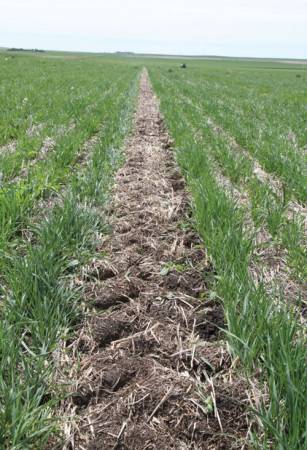
A farm north west of Morrin is trying out a new farming technique in Alberta on their crop this year, which has the farming community watching closely.
The technique is Controlled Traffic Farming (CTF), where farm vehicles go down the same tracks spaced every 30 feet across the field, in exactly the same place year in year out.
This reduces soil compaction by confining it to the smallest possible area, leaving the remaining soil undamaged for cropping, thus improving its yield.
Running over the same tracks also reduces fuel costs as the wheels of machines are always running on compact traffic lanes and so rolling resistance is minimized.
Farmer and agronomist Steve Larocque, a graduate from Olds College and the University of Lethbridge, converted part of a family owned farm to Controlled Traffic Farming (CTF).
The CTF method of farming is hoped to increase profit and improve sustainability, especially with the soil and weather conditions found in Alberta.
Larocque, who runs a consultancy service called Beyond Agronomy, told The Mail he came across this method of farming when he was travelling New Zealand and Australia on a Nuffield Scholarship he was awarded in 2008 and also England when he returned to study the technique further.
“I chose New Zealand and England because of the wet climate and Australia for the dry climate, and that’s exactly Canada, it’s either too dry or too wet!” he explained.
Impressed with what he saw, Larocque decided to try the technique himself.
Helped by his brother-in-law and his father-in-law, he converted the Morrin farm this year and he believes this is the first fully converted farm in Alberta.
Larocque said it was a difficult system to put in place for them as they chose to modify all their wheeled equipment themselves, from tractor, drill, sprayer to combine.
“Every sort of axles that run across the field would have to have 10 foot centres.”
The biggest investment they had to make was the technology he said.
Technology-wise, Larocque invested in Real Time Kinetics (RTK) guided autosteer.
RTK give sub-inch accuracy and allows the equipment to keep to the exact same path year after year, whereas other technology available, such as EGPS, can vary up to eight inches.
So far, the results are looking good.
“The results are going to be a little more prevalent to our benefit, given that we farm heavy clay soil and we have minimized our compaction.”
Fuel economy could be up to 50 per cent said Larocque.
“We measured fuel consumption during seeding this year. Because over time, the tracks will be like cement, and not soft clay which adds a lot of rolling resistance. The producers in Australia were seeing 30 to 50 per cent reduction in fuel use across the farm,” explained Larocque, adding that they should start seeing this economy next year.
There is a couple of drawbacks to the system Larocque is conscious of.
One being residue management in the fall.
“You really have to spread the residue evenly across the combine, because if you are going over the same tracks every year, you can’t keep piling up all that straw and chap on the same rows year after year.”
Harvest logistics is another one to watch as the grain cart will need to run all the way down the field on the head land and then onto the approach.
“I think that’s what everybody is going to struggle with. That will be hard...It’s going to take a little more time so if your capacity is already maxed out, when you’ve got one grain cart and three combines, that grain cart trying to keep up is going to be a little challenging.”
Larocque said dealing with residue management is the next project he will be looking at.
















